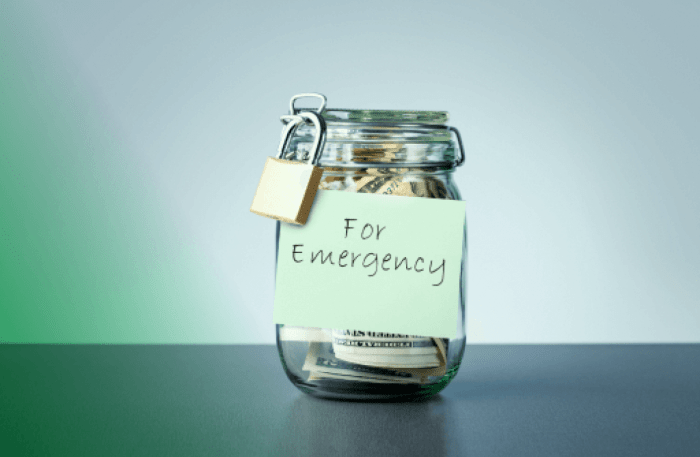Yo, listen up! Emergency fund planning is like the secret weapon in your financial arsenal. It’s all about being prepared for those unexpected curveballs life throws your way. So, buckle up and let’s dive into the world of emergency fund planning!
Importance of Emergency Funds

Having an emergency fund is super crucial for keeping your finances stable, especially when unexpected expenses pop up out of nowhere. It’s like having a safety net to fall back on when things go south.
Examples of Unexpected Expenses
- Medical emergencies – Imagine having to rush to the hospital for a sudden illness or injury. Without an emergency fund, you could end up drowning in medical bills.
- Car repairs – Your ride breaks down unexpectedly, and you need to shell out a hefty sum to get it back on the road. An emergency fund can save the day.
- Job loss – Losing your source of income can be a nightmare, but having an emergency fund can help cover your expenses while you search for a new job.
Peace of Mind and Reduced Stress
Having an emergency fund not only saves you from financial disasters but also gives you peace of mind. Knowing that you have money set aside for emergencies can alleviate stress and help you sleep better at night. It’s like having a secret superpower that protects you from life’s curveballs.
Calculating the Ideal Emergency Fund Amount
In order to determine the perfect emergency fund amount, it’s important to consider various factors that can impact your financial stability in times of need.
Different Methods for Determining the Ideal Emergency Fund Amount
- Fixed Amount: Some financial experts recommend saving a specific dollar amount, such as $1,000 or $5,000, as a starting point for your emergency fund.
- Percentage of Income: Another approach is to save a certain percentage of your monthly income, like three to six months’ worth of expenses.
Factors to Consider When Calculating the Ideal Emergency Fund Amount
- Monthly Expenses: Your emergency fund should cover at least three to six months’ worth of living expenses, including bills, groceries, and other essentials.
- Dependents: If you have dependents or family members relying on your income, you may need a larger emergency fund to account for their needs.
- Job Stability: Individuals with unstable or commission-based income may need a larger emergency fund to cover any income gaps or unexpected job loss.
Real-Life Scenarios Illustrating Varying Emergency Fund Amounts
- Case 1: Sarah, a single college student living on her own, may only need a smaller emergency fund to cover basic expenses like rent and food.
- Case 2: Mark, a married father of three with a mortgage, car payments, and other financial responsibilities, may require a larger emergency fund to support his family in case of emergencies.
Building an Emergency Fund
Building an emergency fund from scratch is a crucial step in financial planning. It provides a safety net for unexpected expenses and emergencies that may arise. Here are some practical steps to start building your emergency fund:
Automate Savings
One effective way to ensure consistent savings for your emergency fund is to automate the process. Set up automatic transfers from your checking account to a separate savings account dedicated to your emergency fund. This way, you won’t even have to think about it, and the savings will grow steadily over time.
Increase Savings Over Time
To increase your emergency fund over time, consider allocating windfalls or unexpected income towards it. This could include tax refunds, bonuses, or any other extra money that comes your way. Additionally, exploring side hustles or part-time gigs can help boost your savings for emergencies. Look for ways to cut back on expenses and redirect that money towards your emergency fund. Small adjustments to your budget can add up over time and contribute significantly to your fund.
Maintaining and Accessing Emergency Funds
Maintaining and accessing your emergency fund is crucial for financial stability. Let’s dive into the details below.
Regularly Reviewing and Replenishing
It’s important to regularly review your emergency fund to ensure it aligns with your current financial situation. Life changes, unexpected expenses arise, and inflation impacts the value of money. Replenishing your emergency fund when necessary will help you stay prepared for any unforeseen circumstances.
Options for Storing Emergency Funds
When it comes to storing your emergency funds, consider options like high-yield savings accounts or money market accounts. These accounts offer higher interest rates compared to traditional savings accounts, allowing your emergency fund to grow over time while remaining easily accessible when needed.
Accessing Emergency Funds
Accessing your emergency fund should be done thoughtfully to avoid compromising your financial security. Only dip into your emergency fund for true emergencies, such as medical expenses, major car repairs, or unexpected job loss. Before withdrawing, consider other options like budget adjustments or temporary side jobs to minimize the impact on your fund.